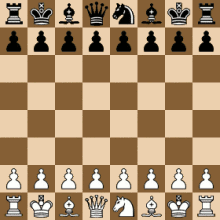|
Bu oyunu oyna
Knightmate ChessThis variant, created by Bruce Zimov in 1972, introduces an interesting goal - to checkmate a knight instead of a king. It means that each player has one knight (at the standard king position) and two kings (at the standard knight positions) - see the next picture:
Regarding this modification, some classic Chess rules are changed as well:
Bu oyunu oyna Bunu da görün: Satranç, Çin Satrancı, Japon Satrancı, Köşe satrancı, Fortress satranç, Horde satranç, Loop satranç, Anti satranç, Extinction satranç, Maharajah satranç, Three Checks satranç, Karanlık satranç, Atomik satranç, Janus satranç, Embassy Satrancı, Screen satranç, Crazy Screen satranç, Silindir satranç, Amazon satranç, Berolina satranç, Fischer Random satranç, Legan Satranç, Knight Relay Satranç, Grand Satranç, Capablanca Random Satranç, Los Alamos Satrancı, Ambiguous Chess, Minishogi, Zar Satrancı, Recycle Satranç, Buz Çağı Satrancı, Behemoth Chess, Cheshire Cat Chess, Knightmate Chess, Racing Kings, Dice Chess 10x10, Massacre Chess |
Tarih ve Saat
Online Arkadaşlarım
Favori Komiteler
Arkadaş Grupları
Günün ipucu
|
|
||||||||||||||||||||||||||||||||||||||||||||||||||||||||||||||||||||||||||
Copyright © 2002 - 2024 Filip Rachunek, tüm hakları saklıdır. Başa Dön |





















